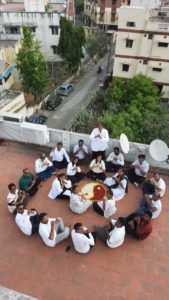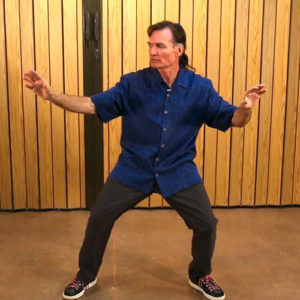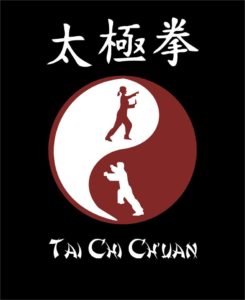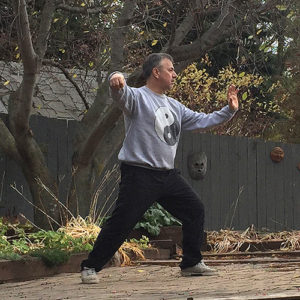Slanted FlyingJournal of Tai Chi Chuan
Training
Taijiquan – Moving Through Molasses
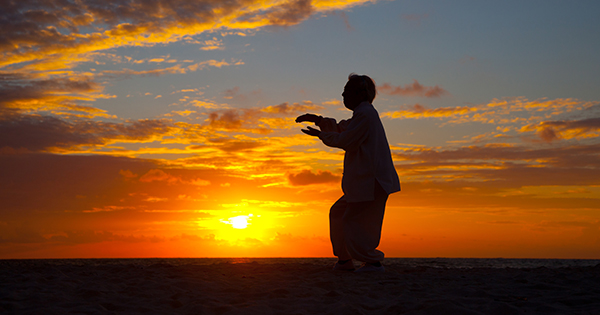 Some Taijiquan (太極拳) practitioners, especially those who are older or who primarily practice for health, tend to practice as softly as possible. Some instead practice as if moving or “swimming” through molasses. This article presents my understanding of the benefits of practicing Taijiquan as if moving through molasses. This practice can be more than simply moving slowly, benefiting also from using modest “resistance” against movement.
Some Taijiquan (太極拳) practitioners, especially those who are older or who primarily practice for health, tend to practice as softly as possible. Some instead practice as if moving or “swimming” through molasses. This article presents my understanding of the benefits of practicing Taijiquan as if moving through molasses. This practice can be more than simply moving slowly, benefiting also from using modest “resistance” against movement.
First let’s examine potential benefits of moving slowly. Slowness allows for using mindfulness, providing time to concentrate on some of the myriad principles important to Taijiquan practice. Taijiquan is sometimes referred to as a moving meditation.
It could be argued that the slowest “movement” is doing stationary postures in zhan zhuang (站樁 standing like a post), a fairly common practice in various traditions. Zhan zhuang for martial arts is not limited to commonly practiced postures like the tree hugging stance (撑抱 cheng bao), but can be any posture from one’s form(s).
For a detailed explanation of zhan zhuang see:
http://taichibasics.com/zhan-zhuang-pole-standing-different-qi-gong-meditation/
While zhan zhuang can develop qi (氣 vital energy) and its circulation, I’ll instead present my understanding of zhan zhuang’s physical practice, since this is less often discussed and is more relevant to this article.
When standing stationary for long periods of time, the body is learning to efficiently resist the force of gravity. This is training for the “stabilizer” muscles, which are often smaller (and powerful) muscles that can remain active for long periods of time, and are used to support the body rather than to move it.
Stationary standing may also activate the passive energy structures, such as tendons and ligaments, which are able to participate in movement without the use of ATP (Ben Fisher, Physical Therapist, personal communication).
Using “mobilizing” muscles instead of the stabilizers to hold stationary postures fatigues them relatively quickly, and can result in severe muscle pain, trembling, and other signs of stress during zhan zhuang training. This is why body builders often do worse at zhan zhuang than average healthy individuals. The body builder’s mobilizing muscles are greatly developed, but this often inadvertently leads to a weakening of the stabilizers because the mobilizing muscles become strong and may take over the job of the stabilizers, resulting in less use of the stabilizers which then become smaller and weaker and/or less coordinated.
The current understanding for strengthening stabilizer muscles is to do numerous reps slowly. This fits well with Taijiquan’s emphasis on doing forms slowly for the duration of the rather lengthy form(s).
Stationary practice trains the stabilizers against gravity, or vertical force, and helps practitioners to develop “rooting” or transferring force through their structure and into their feet, and therefore into the ground. But we want whole-body structural stability in every direction since interactions with other practitioners or opponents can come from almost any direction.
All-direction stability can be facilitated through practicing solo forms with the modest resistance, against every surface of the body and in every direction, that visualizing moving through molasses provides.
Another way of expressing a similar concept is practicing solo forms as if against an opponent. This imagery contributes modest resistance to pulls and pushes as a practitioner moves through the sequence of their solo form(s), and aids one’s mental focus, or intent (用意 yongyi). We want to develop a unified structure, utilizing the stabilizer muscles, tendons and ligaments, in relation to any incoming or outgoing force, in any direction.
I often use the image of a properly inflated ball to express the six-direction force. The limitation here is that the air filling the ball only expresses energy outward, not inward (although the material of the ball contains the air and would therefore be like an inward force). In martial usage of Taijiquan, we want the stabilizers, tendons and ligaments to provide the unified structure for pulling and pushing, absorbing and projecting.
By developing the ability to express force in all directions (or to maintain the potential in all directions simultaneously even when one or more direction is being emphasized during an application), practitioners will maintain their ability to change even when moving. This is especially difficult during the unpredictability of fighting.
Maintaining six-direction force throughout one’s movements also helps to maintain “central equilibrium” (中定 zhongding). Using stabilizing muscles, tendons and ligaments to withstand/absorb incoming energy and for stabilizing the structure when issuing energy also leads to the resilient, whole-body unity that we seek in Taijiquan practice and application.
If we properly use the stabilizing muscles, tendons and ligaments to maintain proper structure, then we can relax the mobilizing muscles, the flexors and extensors, which are the larger and more noticeable muscles generally located closer to the surface of the body (those that can “bulk up”). This is one way of understanding the use of internal strength rather than external strength. It also means that we are not losing our sensitivity due to tension in our outer musculature.
While some practitioners understand internal strength as meaning that we should use energy rather than muscles, I think that this may be somewhat misinterpreted. My understanding is that internal and external are differentiated by what is or is not visible on the surface of the body. The larger muscles (as well as fat, etc.) that contribute to what we can visibly see on the surface of the body are considered to be external, whereas the smaller, deeper muscles, as well as tendons and ligaments whose effects do not visibly affect the surface of the body, are considered to be internal.
From this perspective, the stabilizing muscles, which are generally smaller and located deeper in the body, would be considered as part of the internal system in addition to energy, spirit, intent, etc. The larger flexor and extensor muscles, typically located closer to the surface of the body, would be considered as being external. So we should be first training the energy and the stabilizer muscles, and only later, after the stabilizers are strong and resilient, should we add the “external” strength of the mobilizing muscles.



